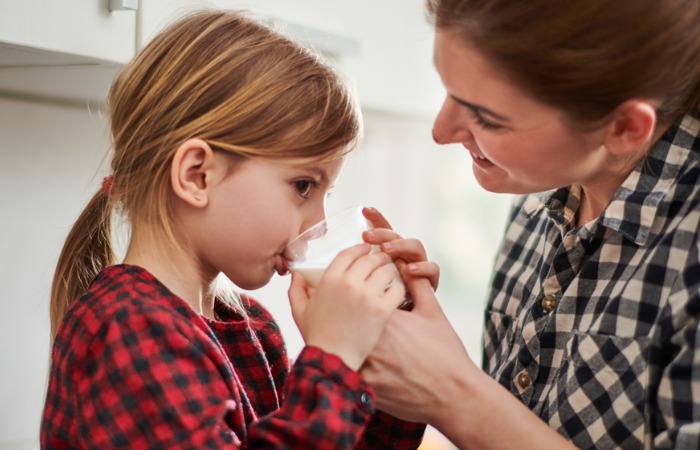Food for thought
In Families
Follow this topic
Bookmark
Record learning outcomes

An Imperial College London analysis of NHS data, published in the British Medical Journal (BMJ) in February, found that deaths from serious allergic reactions to food have declined over the past 20 years. But hospital admissions for food-induced anaphylaxis have risen over the same time period.
Cow’s milk is the most common single cause of fatal food-induced allergic reactions in school-aged children, say the Imperial College researchers. "There is now a lot of awareness of allergies to peanut and tree nut, but many people think milk allergy is mild, perhaps because most children outgrow it," says Dr Paul Turner from Imperial’s National Lung and Heart Institute, lead author of the research. "However, for those who don’t, it remains a big problem because milk is so common in our diet, and people don’t realise how dangerous it can be."
According to research from the University of East Anglia, many parents of children with medically diagnosed food allergies are living in fear. The study of 195 parents found that more than 80 per cent face 'significant worry' about their child’s food allergy, while 42 per cent met the clinical cut-off for post-traumatic stress symptoms (PTSS) and 39 per cent reported moderate to extremely severe anxiety. In the study, around half of the children had been rushed to hospital at least once because of an allergic reaction.
"Caring for a child with a food allergy can be really challenging – not least because they can be exposed to the foods they are allergic to, even with very careful management," says Dr Kate Roberts, who carried out the study and now works at Cambridgeshire Community Services NHS Trust and the Queen Elizabeth Hospital King’s Lynn. "Parents who reported their child to have had an adrenaline auto-injector (AAI) administered were around seven times more likely to report clinically significant PTSS. This really highlights the need for greater awareness about the mental health problems that parents of children with food allergies may be experiencing."
Allergy or intolerance?
According to the BDA (the Association of UK Dietitians), up to 10 per cent of adults and children have a food hypersensitivity – either a food allergy or a food intolerance. Food allergies occur when the immune system reacts to an otherwise harmless food protein. An immediate allergic reaction (e.g. an itchy rash, vomiting) usually involves IgE antibodies. Very severe cases can lead to anaphylaxis. Delayed symptoms don’t involve IgE antibodies and are called non-IgE mediated food allergies. These reactions tend to cause digestive symptoms such as diarrhoea or constipation, and/or skin reactions such as eczema.
Food intolerances don’t involve the immune system and are rarely life threatening. They tend to cause wind, bloating and other digestive symptoms, or skin rashes – sometimes several hours after eating the food.
many parents of children with medically diagnosed food allergies are living in fear
Food allergies often first arise in early childhood, although they can develop at any age. "Eight per cent of children in the UK will have had an immediate allergic reaction to food by the time they reach school age," says Gideon Lack, professor of paediatric allergy at Kings College London, and consultant paediatric allergist at The Portland Hospital. "The rise in allergies in children has been linked to the rise in eczema in babies, along with changes in the microbiome (bacterial diversity) inside the body. Increased frequency of bathing with soap and detergents can disrupt the skin’s natural protective barrier, causing eczema and dry skin. If traces of food on the parents penetrate through their baby’s dry skin, the baby’s immune system views these food molecules as invading parasites and mounts an allergic response. Babies who are introduced to eating solids early on are less likely to develop food allergies."
Telltale symptoms in babies
Cow’s milk allergy is estimated to affect up to seven per cent of babies, with nearly all cases being diagnosed before they reach one year. "Babies who present to a pharmacy with eczema or dry skin may be showing telltale signs of food allergies developing," says Professor Lack. "Food allergies to milk, eggs, peanuts, etc, can cause immediate symptoms (within one minute to an hour) such as urticaria, vomiting, a runny nose and wheezing. Sometimes a baby may pick up a food and have local hives. If they eat the food, there may be a rash on their mouth and cheeks. Delayed allergic reactions to milk can cause severe reflux, possetting or vomiting, and discomfort feeding. Cow’s milk enterocolitis can cause streaks of blood and mucus in the stools. This doesn’t just affect bottle-fed babies, but can be triggered by milk molecules in breast milk, from the mother’s diet. Food protein induced enterocolitis syndrome (FPIES), which isn’t so common, causes profound vomiting after eating food and makes the baby very unwell."
Laura Phillips, paediatric allergy dietitian at Allergy UK, says milk allergy is often confused with lactose intolerance. "Lactose intolerance is uncommon in young children and is not an allergy, but is when the body can’t digest the milk sugar lactose. The most common form of lactose intolerance is temporary – for example, after a bout of gastroenteritis – and can resolve in around six weeks when the gut heals."
According to the BDA, if a baby has been diagnosed as having a cow’s milk allergy and has ongoing allergic symptoms (such as diarrhoea and/or eczema) while being breastfed, mothers may be advised to exclude cow’s milk from their own diet. If a baby has a cow’s milk allergy and is being bottle-fed or mixed fed, their doctor or another healthcare professional will prescribe the most suitable 'hypoallergenic' formula milk. Cow’s milk alternatives are available on prescription for younger children and over the counter for older children.
"Managing a food allergy in children or babies can be stressful, not only for the child, but also for the parents," says Ms Phillips. "There are three key things to be on top of when it comes to managing a food allergy: identify and avoid the cause (if possible); recognise the symptoms of an allergic reaction; know what to do if it happens again."
Allergy management
If customers discuss food reactions with the pharmacy team, it’s important to establish whether or not they could have a food allergy. According to the BDA, up to 20 per cent of people mistakenly believe they have food allergy or intolerance because they experienced some symptoms after eating a particular food.
Ms Phillips says community pharmacists can help to distinguish whether or not the symptoms are allergy-related and direct customers to the relevant healthcare services. "In young children, parents are often seeking reassurance as much as getting access to the correct treatment," she says. "Many parents will seek help from a community pharmacist for advice on an age-appropriate antihistamine as a rescue remedy in case of immediate food allergies. Many children will be referred to allergy clinics where an appropriate management plan will be provided, but there may be a delay in getting access to these services."
Anyone who suspects they have a food allergy should be referred to their GP for appropriate diagnostic tests. Avoiding certain foods without advice from a dietitian can put people at risk of nutritional deficiencies. "Allergy testing for IgE mediated (immediate) allergy is done by skin prick testing and/or blood tests which test for specific IgE against particular allergens such as peanuts," says Ms Phillips. "Oral food challenges (a supervised feed in a hospital or allergy clinic) can help confirm or rule out food allergy. Not all types of food allergy are diagnosed by clinical tests. Non-IgE (delayed) allergy diagnosis involves a trial of eliminating the suspect food from the diet over a period of time and then reintroduction, which should always be guided by a healthcare professional."
Setting up an allergy testing service
Some community pharmacies offer IgE allergy testing services. "Most involve taking a fingerprick blood test, which screens the patient for the most common allergens – both food or inhaled," says Neil Scobie, head of member offer and engagement at Alphega Pharmacy UK. "The pharmacist or trained team member can then interpret the results and give the patient the appropriate advice, which may be to alter lifestyle or in some cases offer treatment. The pharmacist may also be authorised to use PGDs to allow them to have additional treatment options beyond those available over the counter."
If pharmacies wish to set up an allergy testing service, they can obtain tests through wholesalers. "It is important that the pharmacy promotes the service that they offer, as many patients wouldn’t automatically think of pharmacy as the first port of call," says Mr Scobie. "Having the whole pharmacy team trained on what the service consists of is also useful. They are often able to signpost patients to the service due to the types of conversations they have with patients at the pharmacy counter every day – certain symptoms can be a trigger."
If pharmacies want to offer an allergy testing service, it is important that the pharmacy team members involved in the service are properly trained. Allergy UK regularly offers online masterclass training events; the first one specifically aimed at pharmacists will be taking place in September 2021. To register interest, visit the healthcare professional pages on the Allergy UK website.

Views of the P3pharmacy category panel
"We do have situations where patients come in with an allergy that’s flaring up and want advice, especially young children who may have eaten something they are allergic to. We always keep liquid antihistamine in store as this acts quickly, and we offer a PGD service. Queries about allergies have increased in the pandemic, with quite a lot of mild allergic reactions to face masks. Keep allergy products by the till and make sure you have tablets and liquid in stock."
Sarina Mughal, Day Lewis, Knightsbridge
"Make sure staff are educated and aware of products that patients could be allergic to. For example, ibuprofen or aspirin, Cerumol ear drops (peanut/soya allergy), certain hair dyes and products like latex gloves. Look at the products in your shop. How many contain potential allergens? Remember to ask appropriate questions when patients are purchasing these products. This will help build relationships, show we care and distinguish us from other retailers."
Ellis Nugent, Well Pharmacy, Llantwit Major, South Wales
"We have seen a reduction in customers seeking advice and treatment for allergies over the last year. Often, queries relate to mild rashes or allergic rhinitis, with customers looking for fast medical intervention to eliminate symptoms. Generic oral antihistamines such as cetirizine always sell well. Anthisan cream is very popular, and we have seen huge growth in sales of NeilMed Nasal Rinse. More customers are looking for generic oral antihistamines rather than branded products."
Selina Gill, locum pharmacist, West Midlands
